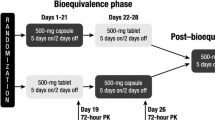Abstract
The non linear relationship between calcitriol (1,25-D3) dose and AUC in cancer patients suggests that the commercially available caplet 1,25-D3 formulation (Rocaltrol) cannot achieve the high systemic exposure associated with antitumor activity in animal models. The primary objective of this analysis was to determine whether a liquid 1,25-D3 formulation had a more favorable pharmacokinetic profile. This analysis was based on the results obtained in 2 phase I clinical studies seeking to determine the maximum tolerated dose of 1,25-D3 administered in combination with either dexamethasone or paclitaxel daily for three consecutive days weekly. Data were available for 12 patients treated with the caplet formulation at doses ranging from 12 μg to 21 μg, and for 16 patients treated with the liquid formulation at doses ranging from 13 μg to 36 μg; data for 19 patients were available at doses for which both formulations were used. There were no differences in Cmax and AUC0–24h between the two formulations (P>0.17) As was noted with the caplet formulation, dose-related proportional increases in Cmax and AUC0–24h were not observed with liquid 1,25-D3 at doses ≥ 13 μg (P>0.83). We conclude that the commercially available liquid 1,25-D3 formulation offers no PK advantage over caplet formulation.




Similar content being viewed by others
References
Colston K, Colston MJ, Feldman D (1981) 1,25-dihydroxyvitamin D3 and malignant melanoma: the presence of receptors and inhibition of cell growth in culture. Endocrinol 108:1083–1086
Chouvet C, Vicard E, Devonec M, Saez S (1986) 1,25-dihydroxyvitamin D3inhibitory effect on the growth of two human breast cancer cell lines (MCF-7, BT-20). J Steroid Biochem 24:373–376
Cross HS, Pavelka M, Slavik J, Peterlik M (1992) Growth control of human colon cancer cells by vitamin D and calcium in vitro. J Natl Cancer Inst 84:1355–1357
Peehl DM, Skowronski RJ, Leung GK, Wong ST, Stamey TA, Feldman D (1994) Antiproliferative effects of 1,25-dihydroxyvitamin D3 on primary cultures of human prostatic cells. Cancer Res 54:805–810
McElwain MC, Dettelbach MA, Modzelewski RA, Russell DM, Uskokovic MR, Smith DC et al (1995) Anti-proliferative effects in vitro and in vivo of 1,25-dihydroxyvitamin D3 and vitamin D3 analogue in a squamous cell carcinoma model system. Mol Cell Differ 3:31–50
Eisman JA, Barkla DH, Tutton PJM (1987) Suppression of in vivo growth of human cancer solid tumor xenografts by 1,25-dihydroxyvitamin D3. Cancer Res 47:21– 25
Getzenberg RH, Light BW, Lapco PE, Konety BR, Nangia AK, Acierno JS Jr et al (1997) Vitamin D inhibition of prostate adenocarcinoma growth and metastasis in the Dunning rat prostate model system. Urol 50:999–1006
Hershberger PA, Modzelewski RA, Shurin ZR, Rueger RM, Trump DL, Johnson CS (1999) 1,25-dihydroxycholecalciferal (1,25-D3) inhibits the growth of squamous cell carcinoma and down-modulates p21 (waf1/Cip1) in vitro and in vivo, Cancer Res 59:2644–2649
Lui M, Lee M, Cohen M, Bommakanti M, Freedman LP (1996) Transcriptional activation of the CDK inhibitor, p21 by vitamin D3 leads to induced differentiation of myelomonocytic cell line U937. Gene Dev 10:142–153
Wang QM, Jones JB, Studzinski GP (1996) Cyclin–dependent kinase inhibitor p27, as a mediator of G1-S phase block induced by 1,25-dihydroxyvitamin D3 in HL60 cells. Cancer Res 56:264–267
McGuire TF, Trump DL, Johnson CS (2001) Vitamin D3-induced apoptosis of murine squamous cell carcinoma cells: Selective induction of caspase-dependent MEK cleavage and up-regulation of MEKK-1. J Biol Chem 276:26365–26373
Bernardi RJ, Trump DL, Yu WD, McGuire TF, Hershberger PA, Johnson CS (2001) Combination of 1α,25-dihydroxyvitamin D3 with dexamethasone enhances cell cycle arrest and apoptosis: Role of nuclear receptor cross-talk and Erk/Akt signaling. Clin Cancer Res 7:4164–4173
Hershberger PA, McGuire TF, Yu WD, Zuhowski EG, Schellens JH, Egorin MJ et al (2002) Cisplatin potentiates 1,25-dihydroxyvitamin D3-induced apoptosis in association with increased mitogen-activated protein kinase kinase kinase 1 (MEKK-1) expression. Mol Cancer Ther 10:821– 829
Wang X, Studzinski GP (2001) Activation of extracellular signal-regulated kinases (ERKs) defines the first phase of 1,25-dihydroxyvitamin D3-induced differentiation of HL60 cells. J Cell Biochem 80:471– 82
Yu WD, McElwain MC, Modzelewski RA, Russell DM, Smith DC, Trump DL et al (1998) Enhancement of 1,25-dihydroxyvitamin D3-untreated antitumor activity with dexamethasone. J Natl Cancer Inst 90:134–141
Muindi JR, Peng Y, Potter DM, Hershberger PA, Tauch JS, Capozzoli MJ et al (2002) Pharmacokinetics of high dose calcitriol: results obtained during a phase one trial of calcitriol and paclitaxel. Cancer Pharmacol Ther 72:648–659
Smith, DC, Johnson CS, Freeman CC, Muindi J, Wilson JW, Trump DL (1999) A phase I trial of Calcitriol (1,25-dihydroxycholecalciferal) in patients with advanced malignancy. Clin Cancer Res 5:1339–1345
Beer TM, Munar M, Henner WD (2001) A Phase I trial of pulse calcitriol in patients with refractory malignancies: pulse dosing permits substantial dose escalation. Cancer 91:2431–2439
Tallarida RJ, Murray RB (1986) Manual of pharmacologic calculation with computer programs. Springer, Berlin Heidelberg New York, pp 197–291
Muindi JR, Modezlewski RA, Peng Y, Trump DL, Johnson CS (2004) Pharmacokinetics of 1α, 25-dihydroxycholecalciferol pharmacokinetics in normal mice after systemic exposure to effective and safe antitumor doses. Oncology 66:62–66
Beer TM, Javle M, Henner WD, Trump DL (2004) Pharmacokinetics (PK) and tolerability of DN-101, a new formulation of calcitriol. Proc Am Assoc Cancer 95:404
Beer TM, Lemmon D, Lowe BA, Henner WD (2003) High-dose weekly oral calcitriol in patients with a rising PSA after prostatectomy or radiation for prostate carcinoma. Cancer 97:1217–1224
Trump DL, Serafine S, Brufsky J et al (2000) High dose calcitriol (1,25(OH)2vitamin D3) + dexamethasone in androgen independent prostate cancer (AIPC). Am Soc Clin Oncol 19:337a
Acknowledgements
Supported by Grants NCI RO1 CA 67267, CA 85142, P30 CA 47904, MO1-RR00056-40 and CaPCURE Award.
Author information
Authors and Affiliations
Rights and permissions
About this article
Cite this article
Muindi, J.R., Potter, D.M., Peng, Y. et al. Pharmacokinetics of liquid calcitriol formulation in advanced solid tumor patients: comparison with caplet formulation. Cancer Chemother Pharmacol 56, 492–496 (2005). https://doi.org/10.1007/s00280-005-1015-2
Received:
Accepted:
Published:
Issue Date:
DOI: https://doi.org/10.1007/s00280-005-1015-2




